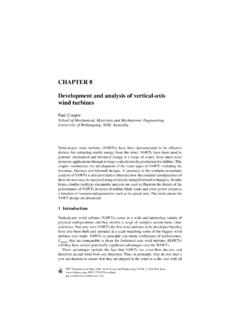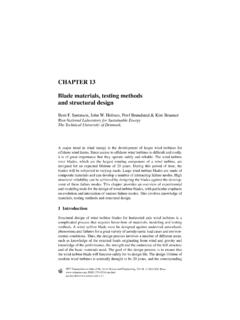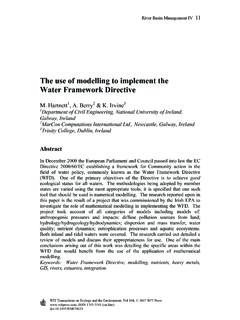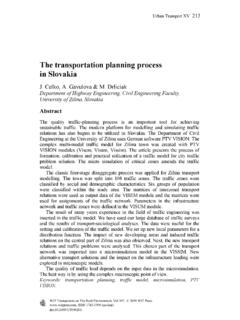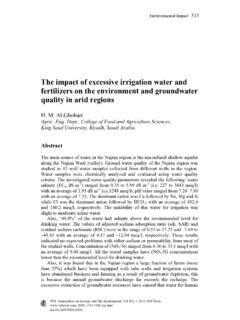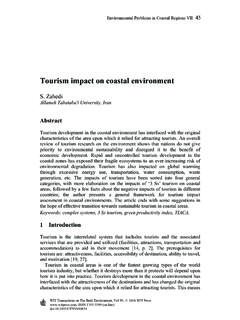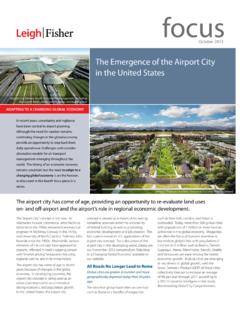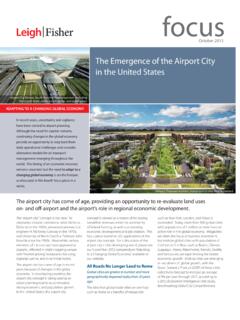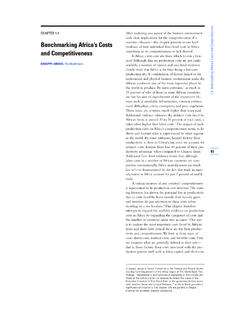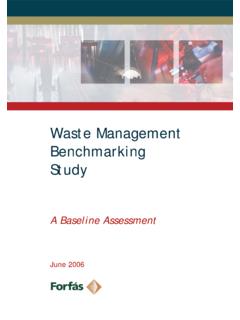Transcription of The critical factors for the competitiveness of cities
1 The critical factors for the competitiveness of cities A. Vegara Business and Territorial competitiveness , Innovation and Sustainability, Deusto Business School, Spain Abstract cities have the ability to provide the conditions for efficient development of companies and to foster quality of life for the people who live and work in that environment. Territorial competitiveness has traditionally been studied at a country scale perspective whilst it has an extraordinary capactity of implementation at the city scale. This paper goes in depth to determine and explain the critical factors that have an impact on cities to become more competitive; analyzes how appropriate is to measure the competitiveness of cities on the basis of competitiveness indicators; concludes that quantitative indicators do not consider relevant qualitative aspects, so it becomes relevant to discover the complexity of the interrelations of the factors of competitiveness in specific cases to identify the critical factors of the competitiveness of cities .
2 Keywords: urban century, competitiveness of cities , benchmarking , city index, city profile, urban indicators, city ranking. 1 Urban century The urbanization process we are experiencing today is unprecedented, in 1950, approximately 30% of the world population lived in cities . In 2000, the percentage of urban population was already 50%. According to certain forecasts, by 2025 approximately 70% of the world population will be urban. Over the next 25 years, nearly 2 million people will be born or live in cities . This process is an extraordinary social and economic challenge, and also a clear business opportunity of global dimension. As recognized by the theme of the Expo Shanghai 2010 , ISSN 1743-3541 (on-line) WIT Transactions on Ecology and The Environment, Vol 204, 2016 WIT paper is part of the Proceedings of the 11 International Conference thon Urban Regeneration and Sustainability (SC 2016) Better city , Better Life , the quality of life on earth depends on our ability to improve our cities .
3 In the international academic community, there is a growing interest in methods of measuring the competitiveness of cities , given the incidence of the cities in the economic development of countries. There is a big debate about how to define competitiveness ; this word has motivated countless debates. competitiveness is a concept that has been in economic and business circles since the 80s. As indicated by Budd and Hirmis [1], the definition of competitiveness suggests different meanings to different authors. Two of the most relevant authors in this field are Krugman [2] and Porter [3]. Krugman believes that the competitiveness of companies only depends on microeconomic factors . On the other side of the debate we find Michael Porter, who believes that the socio-economic environment and the territory, where the companies are located, have a fundamental impact on the competitiveness of different firms.
4 Around Krugman s position we can find visions with different nuances from the economic point of view such as those provided by Siggel [4], Laos [5], and Graham [6]. Following Porter s point of view, it is very interesting the position of authors such as Turok [7], Begg [8], Sobrino [9], and Camagni [10] who truly believe that competitiveness is not only about microeconomic factors but also the territory and the city offer special conditions to improve the performance of companies. Therefore, following these latter authors, it seems clear that local stakeholders such as entrepreneurial leaders, local government, and even, civic society organizations have a key influence on competitiveness . According to The Economist Intelligent Unit [11], cities nowadays generate more than 80% of global GDP.
5 Even more, multinational firms are beginning to plan their locational strategies considering the singularity of the cities , the quality of life and the business ecosystem rather than only the country characteristics. This observation is totally aligned with the latest competitiveness of cities report 2014 by World Economic Forum [12], and particularly their conclusions on how cities of the world are able to create competitive advantages. Therefore, cities clearly open a new framework for the study of competitiveness . In recent years, the competition and cooperation between cities has received attention in academic writing. Today there is a growing consensus that Nation States are not really the only relevant operational and economic units in the new economy, but the cities and their regional environments are the key players of the global economy.
6 cities compete with each other in many different fields, it is for this reason that tools such benchmarking and Index of competitiveness are becoming more relevant. There is no doubt that firms compete today, not only locally, but also globally due to the availability of information, increasing market transparency and progressive elimination of barriers to international trade. As we could observe in Glaeser s book Triumph of the city [13], cities play a major role in today s economy and could be considered civilization s best invention. 48 The Sustainable city XI , ISSN 1743-3541 (on-line) WIT Transactions on Ecology and The Environment, Vol 204, 2016 WIT Press The key issue in connecting cities and competiveness is if the mayors and city leaders can do something to improve the competitiveness of businesses in their towns or regions, or if in fact, these territories are competitive because of the companies that have settled there.
7 cities are the commanding hubs of a globalizing world and city rankings are becoming a relevant tool used by cities and policy makers to better understand the singularities, the urban profile and their position in the world of cities . We see a strong controversy in economic circles about the very concept of competitiveness and about the key factors of urban competitiveness . benchmarking studies are becoming more relevant and more popular when designing urban policies today. Regarding this debate, Florida [14] introduces the concept of the creative class, and how cities that are able to attract talent tend to be more prosperous. cities are diverse in nature, with its own idiosyncrasy and singularities. It is not appropriate to apply one size fits all approach to face urban challenges.
8 As highlighted in different publications referred in this article, each city has a unique combination of size, investment capacity and institutional framework . cities , and particularly major cities , are expanding their influence in their regions and globally. cities of today are becoming the main centres of political power, concentration of talents, hubs of education, research, arts and culture as stated by Moonen and Clark [15]. As this urban century evolves, the essential requirements of city competitiveness , those of growth, skills, enterprise and trade have now been coupled with the need for sustainability, resilience, and livability; transparency and governance; innovation, culture, distinctiveness, and adaptability, amongst then many more qualities that we demand of the city in order to shelter, entertain, inspire and encourage us.
9 It is especially relevant in this new century of cities the need for physical and virtual connectivity. cities do not live in isolation; they compete and cooperate with other cities . In this context, city benchmarking and learning from best practices are becoming more relevant in a globalized world. 2 city rankings In spite of the relevance of cities in this new century, Urban Science concepts and methodologies are still going through a major evolution. It is important to highlight that many of the great challenges that cities are facing do not have a major framework of study and it is difficult to measure and compare initiatives and performance in different cities . city Indexes are becoming very useful for benchmarking cities and to understand how they behave in relation with other cities .
10 Indicators and Indexes can help to measure the level of competitiveness of a city or a city region. Measuring certain key urban indicators, and providing relevant comparisons through benchmarking analysis, allows stakeholders of the city to make appropriate decision to achieving specific objectives. Even though these city studies of ranking are very refined and robust, the methodologies are still evolving and need to be improved. The Sustainable city XI 49 , ISSN 1743-3541 (on-line) WIT Transactions on Ecology and The Environment, Vol 204, 2016 WIT Press It is important to highlight that the origin of the benchmarking studies in the field of cities is quite diffuse. According to our research, Places Rated Almanac in 1981 [16] and UBS Survey Price and Earning Survey [17] in 1970 could be considered the some of the initial works of ratings and indexing cities .
